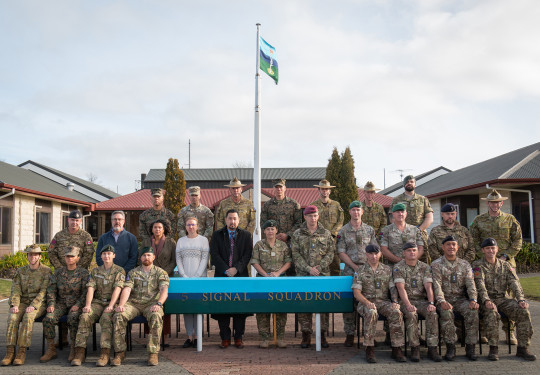Five Eyes partners workshop Electronic Warfare environment
The 1st Command Support Regiment (1CSR) has hosted a Five Eyes Tactical Land Electronic Warfare Conference at Burnham Military Camp this month.
27 August, 2025
Military and civilian personnel from Australia, Canada, United Kingdom and United States worked with a range of New Zealand Defence Force personnel to discuss operational updates and collaboration opportunities.
Electronic Warfare involves the ability to intercept enemy communications to provide intelligence reports and support to targeting, while also providing the ability to disrupt an enemy’s use of radio communications through offensive jamming.
Major Gareth Desborough, Officer Commanding 5th Signal Squadron, 1CSR, says Electronic Warfare is a topic front of mind for Five Eyes partners.
“The role of electronic warfare in the battlespace has long played a significant role in detecting threats and delivering non-kinetic (non-physical combat) effects across the electromagnetic spectrum,” he says.
The New Zealand Defence Force may be small compared to some of its partners, but its problems are very similar to larger forces.
“The rate of technological change and introduction of new capabilities within any given operating environment coupled with the NZ Army’s relatively small size equates to an increased reliance on partner relationships with likeminded units.”
In 2019, leadership elements from the various Five Eyes land EW units agreed and signed a Charter that sought to provide an environment for shared training and operational updates as well as collaborative opportunities achieved largely through an annual conference.
“For 2025, it was New Zealand’s turn to host.”
Services and units included the United States Marine Corps, US Army (Pacific), British Army, Royal Marines, Australian Army, and Canadian Armed Forces.
The conference focused on enhancing partner relationships, identifying future training and operational opportunities, learning from Ex Talisman Sabre 2025, and undertaking a series of working groups looking to tackle common problems.
Major Desborough says it is imperative that the Defence Force works with its closest partners to reduce the risk posed by an ever-changing technological battlespace.
“By working together in examples such as this, we can work collaboratively to close the gaps and mitigate risk as a partnership rather than as individual forces. It gives our operators a chance to benchmark themselves against their peers and learn from others who are operationally active in this space.”
